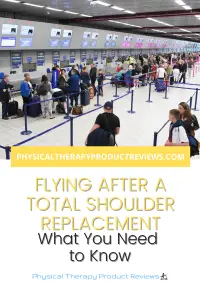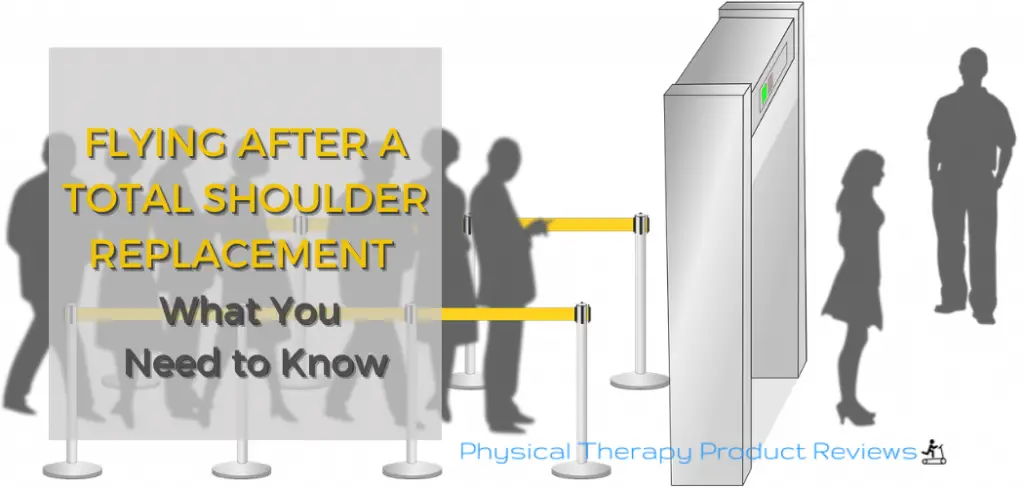 Life happens, and it doesn’t always have the most convenient timing. If you’re recovering from a total shoulder replacement, I’m sure you know a thing or two about inconveniences. But, canceling a flight after surgery doesn’t have to be one.
Life happens, and it doesn’t always have the most convenient timing. If you’re recovering from a total shoulder replacement, I’m sure you know a thing or two about inconveniences. But, canceling a flight after surgery doesn’t have to be one.
Flying after a total shoulder replacement might seem scary at first, but it can go just as smoothly as any pre-surgery flight with the proper research and preparation.
When is it Safe to Fly After a Total Shoulder Replacement?
Chances are you won’t be ready to jump on the first flight available. Give yourself time to heal before you go jet-setting around the world. By the time you’re comfortable enough to remain in a seated position, you should be able to fly.
You should be able to fly as soon as 14 days after surgery, but the safest thing to do is wait until six weeks have passed.
If you have to fly before then, check with your doctor. They’ll most likely recommend you take blood thinners to prevent blood clots.
Your New Shoulder Joint and Security
Airport security is one of life’s necessary hassles. Now that you’ve had your shoulder replaced, it might be even more of a concern.
About 52% of travelers with total shoulder replacements set off the security gate, so it’s a good idea to take preemptive measures to make your trip through security a smooth one.
Caring for Your Shoulder While Flying
Flying after a total shoulder replacement is possible, but you’ll need to consider a lot more than the actual flight. Protect your shoulder from the moment you enter the airport.
- Luggage: Pack light and make sure your suitcase is easy to pull with one arm.
- Time: If you’re in a rush, you’re more likely to make mistakes. Give yourself extra time to check-in, make it through security, and get to your gate at a slow pace. Jostling through crowds or jogging to make your flight are both detrimental to your healing shoulder.
- Sling: Wear your sling, even if it’s uncomfortable or bulky. It will help protect your shoulder during the trip through the airport and through any turbulence your flight might experience.

Pain Management and Medication
Continue taking your pain medication as recommended by your doctor. You can travel with your pain medication as long as it is in solid (pill) form and is screened properly in your carry-on or checked baggage.

Unless otherwise instructed by your doctor, continue taking your pain medication as prescribed. Depending on your health history, your doctor may also recommend medication to prevent blood clots.
Helpful Tips for Flying After A Total Shoulder Replacement
Are you still concerned about your flight? Just follow your doctor’s advice and these helpful tips when returning to the skies.
Get a TSA Pre-Check
You have a 50/50 chance of setting off security with your new shoulder joint. Save yourself the stress and get a TSA Pre-check.
You can apply for a Pre-check online at tsa.gov/precheck and go to a 10-minute appointment. This pre-check will take some pressure off of going through security with your healing shoulder by:
- Decreasing wait time: Most people wait less than 5 minutes to go through.
- Decreasing movement: You won’t be required to remove your shoes, laptops, liquids, belts, or light jacket.
Ask Your Doctor For a Letter
 Individual airlines have specific guidelines about mobility and traveling. At a minimum, you should ask your doctor for an official letter detailing your clearance to travel.
Individual airlines have specific guidelines about mobility and traveling. At a minimum, you should ask your doctor for an official letter detailing your clearance to travel.
We recommend checking with the airline or airlines you’re flying with. They may require a clearance card or form to be filled out by your doctor.
Protect Yourself Against Blood Clots
Recent surgeries, prolonged sitting, and dehydration are all contributing factors to blood clots. Flying can exacerbate these risks. If you must fly within 6 weeks of surgery, here are some things you should do to minimize the risk:
- Ask your doctor if you should take a blood thinner before your flight.
- On long flights, stand and move around a bit every couple of hours when permitted.
- Wear compression stockings to decrease swelling and prevent blood clots.
- Ask your doctor about taking aspirin before your flight.
Choose an Aisle Seat
To make yourself more comfortable, try and pick a seat with more space. If you can afford to fly 1st class, you shouldn’t have an issue finding enough room to stretch out.
Otherwise, try and pick an aisle seat but with your surgical arm away from the aisle. There is nothing worse than a drink cart or a kid running down the aisle bumping into the new surgically repaired shoulder. The aisle seat lets you quickly stand up and stretch out your arm.
Tip: You’ll be tempted to try and book an exit row seat to get the extra room but avoid the temptation. You’ll be asked if you are physically capable of helping people in the event of a very rare emergency, but it’s not worth the risk for the shoulder.
Flying After Surgery
Conclusion
Don’t miss out on something fun or necessary out of fear. Talk to your doctor and see if you are clear to fly. If you’re cleared, pack light, get pre-checked and follow guidelines from your doctor to make your flying experience as easy as possible.
Works Referenced:
https://pubmed.ncbi.nlm.nih.gov/17507250/
https://jmclean.com.au/your-visit/after-surgery/flying-after-surgery/
https://www.hipsandkneereplacement.com/when-is-it-safe-to-travel-after-your-joint-replacement/
https://www.cancer.net/blog/2015-06/getting-medical-clearance-fly
Other Great Rehab Related Articles
How to Stay Active After Cervical Fractures: Expert Tips and Advice
Dealing with Painful Stairs After Ankle Replacement Surgery
Walking After a Total Ankle Replacement: Tips for a Successful Recovery
Exercises While Non-Weight Bearing After Ankle Replacement: Elevation, AROM, Leg Raises, and More
Ankle Pain with Stairs: Causes and Home Treatment Options
5 Common Mistakes You’re Making After an Ankle Sprain
Disclaimer: The information provided in this post is for educational purposes only. This is not a substitute for a medical appointment. Please refer to your physician before starting any exercise program.






